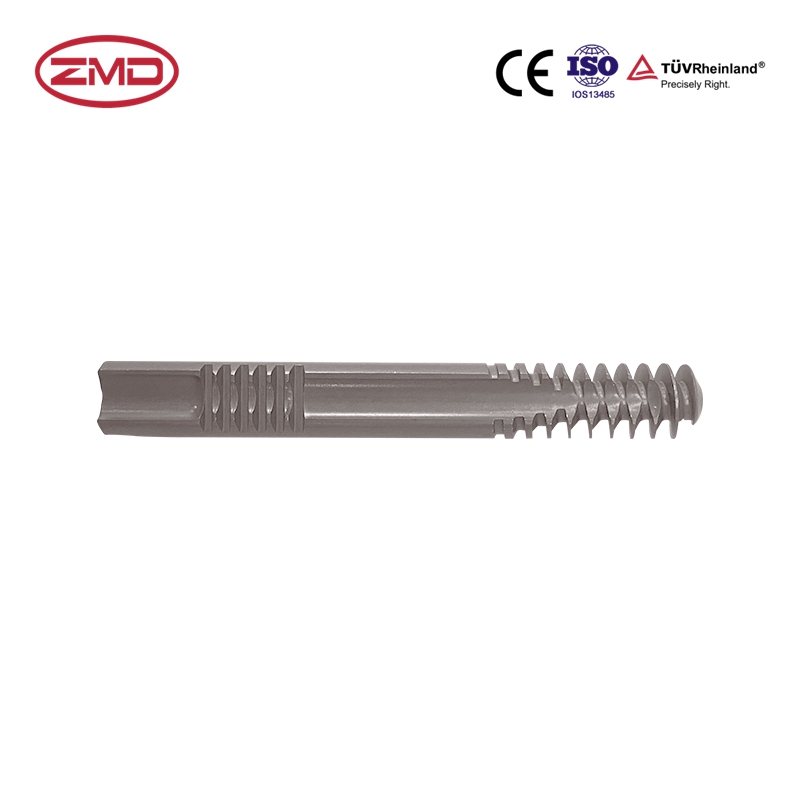
- Home
- About Us
- Products
- Trauma Internal Fixation System
- Spinal Internal Fixation System
- External Fixation
- Artificial Implants System
- Sports Medicine
- Power tools
- VSD System
- Instruments
- Medical supplies
- Blog
- Personnel Profile
- Contact Us
Phone line
1.Specialized Design: Compression screws are specifically designed to exert compressive forces on bone fragments, promoting fracture healing and reducing the risk of implant migration.
2.Versatile Application: Suitable for a wide range of orthopedic and trauma surgeries, including fracture fixation, osteotomy, and plate augmentation.
3.Biocompatible Material: Typically made from high-grade titanium or stainless steel, ensuring excellent biocompatibility and minimal risk of rejection or inflammation.
4.Adjustable Compression: Allows for precise control of compression forces, tailoring fixation to individual patient needs and fracture patterns.
5.Strong Fixation: Provides reliable fixation of bone fragments, contributing to successful surgical outcomes.
| Code | Product name | Size |
| 4226.0760 | Compression Screw | 7*60mm |
| 4226.0765 | Compression Screw | 7*65mm |
| 4226.0770 | Compression Screw | 7*70mm |
| 4226.0775 | Compression Screw | 7*75mm |
| 4226.0780 | Compression Screw | 7*80mm |
| 4226.0785 | Compression Screw | 7*85mm |
| 4226.0790 | Compression Screw | 7*90mm |
| 4226.0795 | Compression Screw | 7*95mm |
| 4226.0700 | Compression Screw | 7*100mm |
| 4226.0705 | Compression Screw | 7*105mm |
| 4226.0710 | Compression Screw | 7*110mm |
| 4226.0715 | Compression Screw | 7*115mm |
Key Features and Benefits of Compression Screw
Compression Screws are specialized orthopedic implants designed to exert controlled compressive forces on bone fragments, promoting fracture healing and reducing the risk of implant migration. Their unique design allows for precise adjustment of compression levels, tailoring fixation to individual patient needs. Crafted from biocompatible materials, compression screws minimize tissue irritation and accelerate recovery. This combination of features makes compression screws a valuable tool for orthopedic surgeons, providing reliable and effective fixation in a wide range of applications.
Indications for Compression Screw
Compression Screws are versatile implants used in various orthopedic and trauma surgeries. Their primary indications include:
How does the Compression Screw Work
A Compression Screw is a specialized orthopedic implant designed to exert controlled compressive forces on bone fragments, promoting fracture healing and reducing the risk of implant migration. During surgery, the screw is inserted into pre-drilled holes in the bone fragments and tightened. As the screw is tightened, it compresses the bone fragments together, creating a stable environment for bone healing. The compression force applied by the screw can be adjusted to optimize fixation based on the specific fracture pattern and patient anatomy. This controlled compression promotes bone callus formation and accelerates the healing process.
FAQ
Q1: What is a compression screw?
A compression screw is a specialized orthopedic implant designed to exert controlled compressive forces on bone fragments, promoting fracture healing and stability.
Q2: How does a compression screw work?
A compression screw is inserted into pre-drilled holes in bone fragments and tightened. This creates compressive forces that bring the fragments together, promoting bone callus formation and healing.
Q3: What materials are typically used for compression screws?
Compression screws are commonly made from high-grade titanium or stainless steel, known for their biocompatibility and strength.
Q4: In which types of surgeries are compression screws used?
They are used in various orthopedic and trauma surgeries, including fracture fixation, osteotomy, and plate augmentation.
Q5: What are the benefits of using a compression screw?
Benefits include enhanced stability, reduced risk of implant migration, improved bone healing, and the ability to tailor compression forces to individual patient needs.
Q6: Are there different types of compression screws?
Yes, there are variations in screw head design, thread pitch, and length to accommodate different surgical needs.
Q7: How is a compression screw inserted and locked into place?
The screw is inserted into pre-drilled holes and tightened, often using a torque wrench to ensure proper compression. Some compression screws may have locking mechanisms to prevent loosening.
Q8: What are the potential risks associated with using a compression screw?
As with any surgical implant, there are potential risks such as infection, hardware failure, and nerve damage. However, these risks are generally low when the procedure is performed by an experienced surgeon.
Q9: How long does it typically take for a bone to heal with a compression screw?
Healing time varies depending on the type of fracture, patient’s overall health, and other factors, but it usually takes several weeks or months.
Q10: How does a compression screw compare to other types of orthopedic screws?
Compression screws offer the advantage of controlled compression forces, making them particularly suitable for fractures that require specific compression levels to promote healing.
Oh yeah! I have to mention their payment options and discount offers, which are awesome! Those payment methods are as flexible as moving water and can be chosen freely according to our cash flow situation. And the frequent discounts, like a timely rain, have been moisturizing our financial statements time and again, and have had a rocket-like positive impact on our profits! With ZMD, I feel relaxed and at ease when it comes to purchasing!
Send us a message if you have any questions or request a quote. Our experts will give you a reply within 24 hours and help you select the right valve you want.
Book Now
If you are looking for professional orthopedic medical product solutions, don’t hesitate to contact us now!

We are an integrated manufacturer specializing in orthopedic medical industry, providing high quality and reliable orthopedic medical products to customers worldwide.
Copyright © 2024 ASK Project